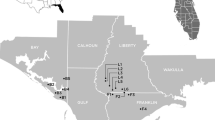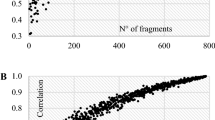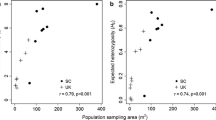Abstract
Sonchus gandogeri, a woody sow-thistle, is an endangered Canary Island endemic with only two known populations, one in the El Golfo and another in the Las Esperillas of El Hierro. Amplified fragment length polymorphism (AFLP) markers were used to assess the genetic variation within and among populations. The mean genetic diversity of two populations was estimated to be 0.380, and the El Golfo population (0.380) had higher genetic diversity than the southeastern one (0.268). The unbiased Nei’s genetic identity between the two populations was 0.846. The mean genetic diversity of S. gandogeri was much higher than that of the other endangered plant species. This is perhaps due to breeding system, life form, extinction, and/or introgressive hybridization and hybrid origin of the taxon. This study also indicates that the two populations are not strongly differentiated (GST=0.149). This study suggests that S. gandogeri is more likely to become extinct due to environmental or demographic forces than genetic factors, such as inbreeding depression. More strict control of introduced herbivores is necessary to protect these populations, and germplasm collection for ex situ conservation is needed.


Similar content being viewed by others
References
Aldridge AE (1975) Taxonomic and anatomical studies in Sonchus L. subg. Dendrosonchus Webb ex Schultz Bip. and related genera. PhD Thesis, University of Reading, Reading
Aldridge AE (1976) Macaronesian Sonchus subgenus Dendrosonchus s. l. (Compositae-Lactuceae), including a reappraisal of the species concept and new combinations. Bot Macaronesica 2:81–93
Aldridge AE (1979) Evolution within a single genus: Sonchus in Macaronesia. In: Bramwell D (ed) Plants and island. Academic Press, London, pp 249–285
Batista F, Bañares A, Caujapé-Castells J et al. (2001) Allozyme diversity in three endemic species of Cistus (Cistaceae) from the Canary Islands: intraspecific and interspecific comparisons and implications for genetic conservation. Am J Bot 88:1582–1592
Beardmore JA (1983) Extinction, survival, and genetic variation. In: Schoenwald-Cox CM, Chambers SM, MacBryde B, Thomas L (eds) Genetics and conservation. Benjamin-Cummings, Menlo Park, CA, pp 125–151
Boulos L (1974) Révision systematique du genre Sonchus L. s.l. V. Sous genre 2. Dendrosonchus. Botaniska Notiser 127:7–37
Bouza N, Caujapé-Castells J, González-Pérez MA, Batista F, Sosa PA (2002) Population structure and genetic diversity of two endangered endemic species of the Canarian laurel forest: Dorycnium spectabile (Fabaceae) and Isoplexis chalcantha (Scorphulariacaeae). Int J Plant Sci 163:619–630
Bramwell D (1976) The endemic flora of the Canary Islands: distrubution relationships and phytogeography. In: Kunkel G (ed) Biogeography and ecology in the Canary Islands, Monographiae Biologicae 30. Junk, The Hague, pp 207–240
Bramwell D (1990) Conserving biodiversity in the Canary Islands. Ann MO Botanical Garden 77:28–37
Bramwell D, Bramwell Z (2001) Wild flowers of the Canary Islands, 2nd edn. Editorial Rueda, Madrid
Bussel JD (1999) The distribution of random amplified polymorphic DNA (RAPD) diversity amongst populations of Isotoma petrea (Lobeliaceae). Mol Ecol 8:775–789
Cardoso MA, Provan W, Powell J, Ferreras PCG, Oliveira DE (1998) High genetic differentiation among remnant populations of the endangered Caesalpinia echinata Lam. (Leguminosae-Caesalpinioideae). Mol Ecol 7:601–608
Carracedo JC (1994) The Canary Islands: an example of structural control on the growth of large oceanic-island volcanoes. J Volcanol Geotherm Res 60:225–241
Chalmers KJ, Waugh R, Sprent JI, Simons AJ, Powell W (1992) Detection of genetic variation between and within populations of Gliricidia sepium and G. maculata using RAPD markers. Heredity 69:465–472
Crawford DJ, Ruiz E, Stuessy TF et al. (2001) Allozyme diversity in endemic flowering plant species of the Juan Fernandez Archipelago, Chile: ecological and historical factors with implications for conservation. Am J Bot 88:2195–2203
De Joode DE, Wendel J (1992) Genetic diversity and origin of the Hawaiian Islands cotton, Gossypium tomentosum. Am J Bot 79:1311–1319
Drummond RSM, Keeling DJ, Richardson TE, Gardner RC, Wright SD (2000) Genetic analysis and conservation of 31 surviving individuals of a rare New Zealand tree, Metrosideros bartlettii (Myrtaceae). Mol Ecol 9:1149–1157
Ellstrand NC, Elam DR (1993) Population genetic consequences of small population size: implications for plant conservation. Annu Rev Ecol Syst 24:217–242
Engler A (1879) Versuch einer Entwicklungsgeschichte, insbesondere der Florengebiete seit der Tertiärperiode. I. Die extratropischen Gebiete der nördlichen Hemisphäre. Engelmann, Leipzig
Francisco-Ortega A, Santos-Guerra A, Kim S-C, Crawford DJ (2000) Plant genetic diversity in the Canary Islands: a conservation perspective. Am J Bot 87:909–919
Frankel OH (1983) The place of management in conservation. In: Schoenwald-Cox CM, Chambers SM, MacBryde B, Thomas L (eds) Genetics and conservation. Benjamin-Cummings, Menlo Park, CA, pp 125–151
Frankham R (1997) Do island populations have less genetic variation than mainland populations? Heredity 78:311–327
Frankham R (1998) Inbreeding and extinction: island populations. Conserv Biol 12:665–675
Franklin ER (1980) Evolutionary change in small populations. In: Soulé ME, Wilcox BA (eds) Conservation biology: an evolutionary-ecological perspective. Sinauer, Sunderland, pp 135–150
Gaudeul M, Taberlet P, Till-Bottraud (2000) Genetic diversity in an endangered plant, Eryngium alpinum L. (Apiaceae), inferred from amplified fragment length polymorphism markers. Mol Ecol 9:1625–1637
Gemmill CE, Ranker TA, Ragone D, Perlman SP, Wood KR (1998) Conservation genetics of the endangered endemic Hawaiian genus Brighmania (Campanulaceae). Am J Bot 85:528–539
Hamrick JL, Godt JW (1996) Conservation genetics of endemic plant species. In: Avise JC, Hamrick JL (eds) Conservation genetics: case studies from nature. Chapman & Hall, NY, pp 281–301
Hamrick JL, Godt JW (1997) Effects of life history traits. In: Silvertown J, Franco M, Harper JL (eds) Plant life histories-ecology, phylogeny and evolution. Cambridge University Press, Cambridge, pp 102–118
Hamrick JL, Godt MJW, Murawski DA, Loveless MD (1991) Correlations between species traits and allozyme diversity: implications for conservation biology. In: Falk DA, Holsinger KE (eds) Genetics and conservation of rare plants. Oxford University Press, New York, pp 75–86
Huenneke LF (1991) Ecological implications of genetic variation in plant populations. In: Falk DA, Holsinger KE (eds) Genetics and conservation of rare plants. Oxford University Press, New York, pp 31–44
Kim S-C, Rieseberg LH (1999) Genetic architecture of species differences in annual sunflowers: implications for adaptive trait introgression. Genetics 153:965–977
Kim S-C, Crawford DJ, Jansen RK (1996a) Phylogenetic relationships among the genera of the subtribe Sonchinae (Asteraceae): evidence from ITS sequences. Syst Bot 21:417–432
Kim S-C, Crawford DJ, Francisco-Ortega J, Santos-Guerra A (1996b) A common origin for woody Sonchus and five related genera in the Macaronesian islands: molecular evidence for extensive radiation. Proc Natl Acad Sci USA 93:7743–7748
Kim S-C, Crawford DJ, Francisco-Ortega A, Santos-Guerra A (1999) Adaptive radiation and genetic differentiation in the woody Sonchus aliance (Asteraceaae: Sonchinae) in the Canary Islands. Plant Syst Evol 215:101–118
Manly BFJ (1985) The statistics of natural selection. Chapman & Hall, London
Menges ES (1991) The application of minimum viable population theory to plants. In: Falk DA, Holsinger KE (eds) Genetics and conservation of rare plants. Oxford University Press, New York, pp 45–61
Nei M (1973) Analysis of gene diversity in subdivided populations. Proc Natl Acad Sci USA 70:3321–3323
Nei M (1978) Estimation of average heterozygosity and genetic distance from a small number of individuals. Genetics 89:583–590
Nei M, Li WH (1979) Mathematical model for studying genetic variation in terms of restriction endonucleases. Proc Natl Acad Sci USA 76:5269–5273
Nuez P, Prohens J, Blanca JM (2004) Relationships, origin, and diversity of Galápagos tomatoes: implications for the conservation of natural populations. Am J Bot 91:86–99
Palacios C, González-Candelas F (1999) AFLP analysis of the critically endangered Limonium cavanillesii (Plumbaginaceae). J Hered 90:485–489
Palacios C, Kresovich S, González-Candelas F (1999) A population genetic study of the endangered plant species Limonium dufourii (Plumbaginaceae) based on amplified fragment length polymorphism (AFLP). Mol Ecol 8:645–657
Rox J, Boulos L (1972) Révision systématique du genre Sonchus L. s. l. II. Étude caryologique. Botaniska Notiser 125:306–309
Saitou N, Nei M (1987) The neighbor-joining method: a new method for reconstructing phylogenetic trees. Mol Biol Evol 4:406–425
Schaal BA, Leverich WJ, Rogstad SH (1991) A comparison of methods for assessing genetic variation in plant conservation biology. In: Falk DA, Holsinger KE (eds) Genetics and conservation of rare plants. Oxford University Press, New York, pp 123–134
Schmidt K, Jenssen K (2000) Genetic structure and AFLP variation of remnant populations in the rare plant Pedicularis palustris (Scrophulariaceae) and its relation to population size and reproduction components. Am J Bot 87:678–689
Stuessy TF, Crawford DJ, M Silva O (1998) Isolating mechanisms and modes of speciation in the vascular flora of the Juan Fernandez Islands. In: Stuessy TF, Ono M (eds) Evolution and speciation in island plants. Cambridge University Press, Cambridge, pp 79–86
Swofford DL (2000) PAUP*: phylogenetic analysis using parsimony (*and other methods). Sinauer, Sunderland
Travis SE, Maschinski J, Keim P (1996) An analysis of genetic variation in Astragalus cremnophylax var. cremnophylax, a critically endangered plant, using AFLP markers. Mol Ecol 5:735–745
Vos P, Hogers R, Bleeker M et al. (1995) AFLP: a new technique for DNA fingerprinting. Nucleic Acids Res 23:4407–4414
Weller SG, Sakai AK, Straub C (1996) Allozyme diversity and genetic identity in Schiedea and Alsinidendron (Caryophyllaceae: Alsinoideae) in the Hawaiian Islands. Evolution 50:23–34
Yeh FC, Young RC, Timothy B et al. (1997) Popgene, the user-friendly shareware for population genetic analysis. Molecular Biology and Biotechnology Center, University of Alberta, Canada
Zawko G, Krauss SL, Dixon KW, Sivasithamparam K (2001) Conservation genetics of the rare and endangered Leucopogon obtectus (Ericaceae). Mol Ecol 10:2389–2396
Acknowledgements
The authors wish to thank Daniel Crawford, Javier Francisco-Ortega, and Norm Ellstrand for helpful comments on an early version of the manuscript. The manuscript was greatly improved by comments from two anonymous reviewers. This project is supported in part by an Academic Senate Grant, Regents’ Faculty Fellowship, and Agricultural Experiment Station funds from the University of California at Riverside to S.-C. Kim. We also thank Cabildo de El Hierro for issuing a permit to collect plants on El Hierro and the ICIA (Instituto Canario de Investigaciones Agrarias) for letting us use their facilities.
Author information
Authors and Affiliations
Corresponding author
Rights and permissions
About this article
Cite this article
Kim, S.C., Lee, C. & Santos-Guerra, A. Genetic analysis and conservation of the endangered Canary Island woody sow-thistle, Sonchus gandogeri (Asteraceae). J Plant Res 118, 147–153 (2005). https://doi.org/10.1007/s10265-005-0203-9
Received:
Accepted:
Published:
Issue Date:
DOI: https://doi.org/10.1007/s10265-005-0203-9




